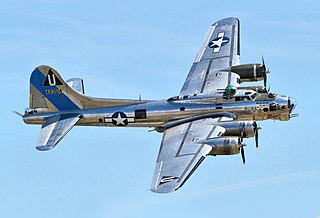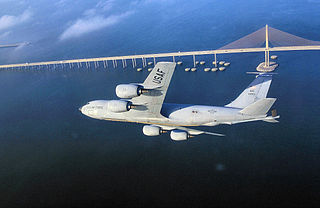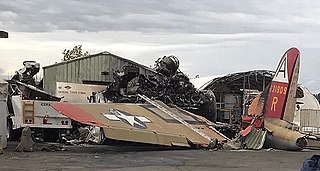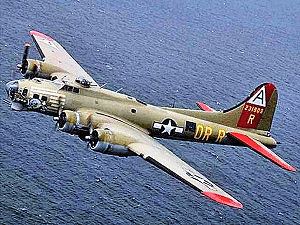
The Boeing B-17 Flying Fortress is an American four-engined heavy bomber aircraft developed in the 1930s for the United States Army Air Corps (USAAC). A fast and high-flying bomber of its era, the B-17 was used primarily in the European Theater of Operations and dropped more bombs than any other aircraft during World War II. It is the third-most produced bomber of all time, behind the American four-engined Consolidated B-24 Liberator and the German multirole, twin-engined Junkers Ju 88. It was also employed as a transport, antisubmarine aircraft, drone controller, and search-and-rescue aircraft.

Liberty Belle was a popular name for United States Army Air Forces (USAAF) aircraft during World War II; over two dozen known individual Boeing B-17 Flying Fortresses and Consolidated B-24 Liberators used the name.

The Memphis Belle is a Boeing B-17F Flying Fortress used during the Second World War that inspired the making of two motion pictures: a 1944 documentary film, Memphis Belle: A Story of a Flying Fortress and the 1990 Hollywood feature film, Memphis Belle. It was one of the first United States Army Air Forces (USAAF) B-17 heavy bombers to complete 25 combat missions, after which the aircrew returned with the bomber to the United States to sell war bonds.

The 91st Bomb Group (Heavy) was an air combat unit of the United States Army Air Forces during the Second World War. Classified as a heavy bombardment group, the 91st operated B-17 Flying Fortress aircraft and was known unofficially as "The Ragged Irregulars" or as "Wray's Ragged Irregulars", after the commander who took the group to England. During its service in World War II the unit consisted of the 322nd, 323rd, 324th, and 401st Bomb Squadrons. The 91st Bomb Group is most noted as the unit in which the bomber Memphis Belle flew, and for having suffered the greatest number of losses of any heavy bomb group in World War II.

Royal Air Force Bassingbourn or more simply RAF Bassingbourn is a former Royal Air Force station located in Cambridgeshire approximately 3 mi (5 km) north of Royston, Hertfordshire and 11 mi (18 km) south west of Cambridge, Cambridgeshire, England.

Royal Air Force Kimbolton or more simply RAF Kimbolton is a former Royal Air Force station located 8 miles (13 km) west of Huntingdon, Cambridgeshire, England.

Shoo Shoo Shoo Baby, originally Shoo Shoo Baby, is a Boeing B-17 Flying Fortress in World War II, preserved and currently in storage at the National Museum of the United States Air Force, awaiting transfer to the Smithsonian's National Air and Space Museum. A B-17G-35-BO, serial number 42-32076, and manufactured by Boeing, it was named by her crew for a song of the same name made popular by The Andrews Sisters, the favorite song of its crew chief T/Sgt. Hank Cordes. Photographs of the bomber indicate that a third "Shoo" was added to the name at some point in May 1944 when the original aircraft commander completed his tour of duty and was replaced by another pilot.

The United States Air Force's 457th Air Expeditionary Group is a provisional United States Air Force unit assigned to United States Air Forces in Europe to activate or inactivate as needed. It has been activated to support Operation Iraqi Freedom, joint operations with the Tanzania Air Force Command and for Operation Odyssey Dawn.

Anthony L. Starcer, was an American soldier and artist during World War II, known for his nose art work.

Texas Raiders was an American Boeing B-17 Flying Fortress, a B-17G-95-DL built by Douglas Long Beach. In 1967, it was purchased by the Commemorative Air Force's Gulf Coast Wing "Texas Raiders" group, which maintained and flew the aircraft out of Conroe-North Houston Regional Airport in Conroe, Texas. The aircraft was destroyed on November 12, 2022, by a mid-air collision with a P-63 Kingcobra at an air show at Dallas Executive Airport, Texas, that killed all five occupants and the P-63 pilot.

The 91st Air Refueling Squadron is part of the 6th Air Mobility Wing at MacDill Air Force Base, Florida. It operates the Boeing KC-135R Stratotanker aircraft conducting air refueling missions.

The 351st Air Refueling Squadron is part of the 100th Air Refueling Wing at RAF Mildenhall, England. Since 1992, it has operated the Boeing KC-135R/T Stratotanker aircraft conducting primarily aerial refueling but also airlift and aeromedical evacuation missions.

The 322d Expeditionary Reconnaissance Squadron is a provisional unit of the United States Air Force, assigned to Air Combat Command to activate or inactivate as needed.

This is a list of United States Army Air Forces B-17 Flying Fortress units of the United States Army Air Forces, including variants and other historical information. Heavy bomber training organizations primarily under II Bomber Command in the United States and non-combat units are not included.
This is a partial list of accidents and incidents involving the Boeing-designed B-17 Flying Fortress. Combat losses are not included except for a very few cases denoted by singular circumstances. A few documented drone attrition cases are also included.

The 3205th Drone Group is a discontinued United States Air Force unit that operated obsolete aircraft during the 1950s as radio-controlled aerial targets for various tests. It was the primary post-World War II operator of surplus Boeing B-17G Flying Fortress aircraft, and also operated Lockheed F-80 Shooting Star and a few Boeing RB-47 Stratojet bombers that were converted into drone aircraft during the early years of the Cold War. It was last active with the Air Proving Ground Center, based at Eglin Air Force Base, Florida, where it was discontinued on 1 February 1961.

On 23 April 1945, a Boeing B-17G Flying Fortress crashed on North Barrule, a hill in the Isle of Man. A total of 31 people were killed. The accident is the deadliest aviation accident to have occurred in the Isle of Man. It was due to controlled flight into terrain (CFIT).

On October 2, 2019, a Boeing B-17 Flying Fortress owned by the Collings Foundation crashed at Bradley International Airport, Windsor Locks, Connecticut, United States. Seven of the thirteen people on board were killed, and the other six, as well as one person on the ground, were injured. The aircraft was destroyed by fire, with only the tail and a portion of one wing remaining.



















